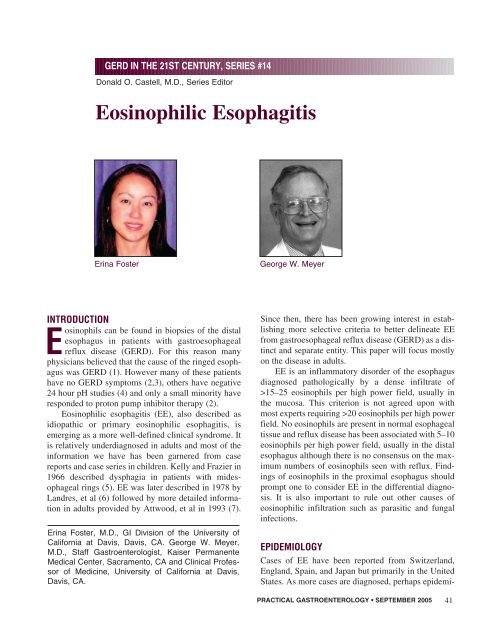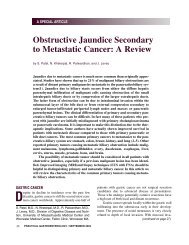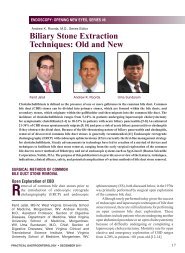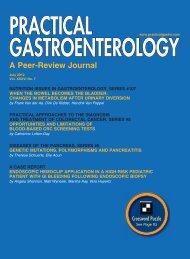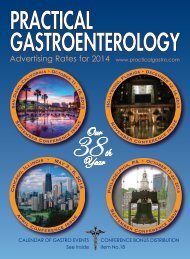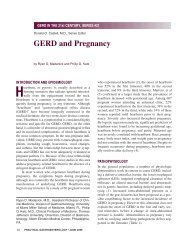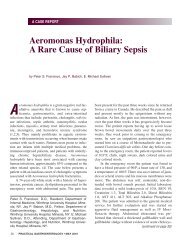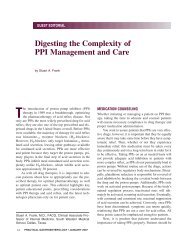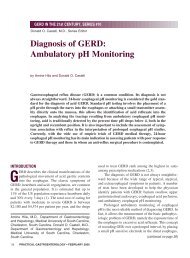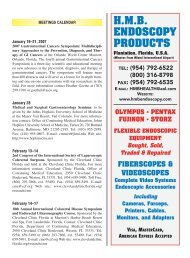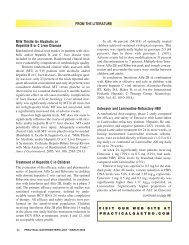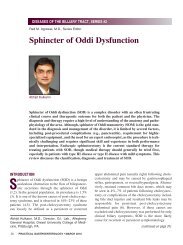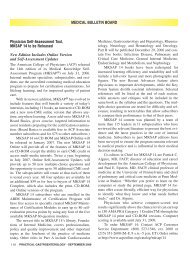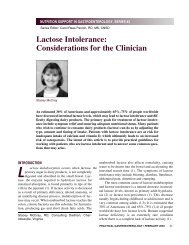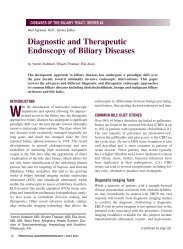Eosinophilic Esophagitis - Practical Gastroenterology
Eosinophilic Esophagitis - Practical Gastroenterology
Eosinophilic Esophagitis - Practical Gastroenterology
Create successful ePaper yourself
Turn your PDF publications into a flip-book with our unique Google optimized e-Paper software.
GERD IN THE 21ST CENTURY, SERIES #14<br />
Donald O. Castell, M.D., Series Editor<br />
<strong>Eosinophilic</strong> <strong>Esophagitis</strong><br />
Erina Foster<br />
George W. Meyer<br />
INTRODUCTION<br />
Eosinophils can be found in biopsies of the distal<br />
esophagus in patients with gastroesophageal<br />
reflux disease (GERD). For this reason many<br />
physicians believed that the cause of the ringed esophagus<br />
was GERD (1). However many of these patients<br />
have no GERD symptoms (2,3), others have negative<br />
24 hour pH studies (4) and only a small minority have<br />
responded to proton pump inhibitor therapy (2).<br />
<strong>Eosinophilic</strong> esophagitis (EE), also described as<br />
idiopathic or primary eosinophilic esophagitis, is<br />
emerging as a more well-defined clinical syndrome. It<br />
is relatively underdiagnosed in adults and most of the<br />
information we have has been garnered from case<br />
reports and case series in children. Kelly and Frazier in<br />
1966 described dysphagia in patients with midesophageal<br />
rings (5). EE was later described in 1978 by<br />
Landres, et al (6) followed by more detailed information<br />
in adults provided by Attwood, et al in 1993 (7).<br />
Erina Foster, M.D., GI Division of the University of<br />
California at Davis, Davis, CA. George W. Meyer,<br />
M.D., Staff Gastroenterologist, Kaiser Permanente<br />
Medical Center, Sacramento, CA and Clinical Professor<br />
of Medicine, University of California at Davis,<br />
Davis, CA.<br />
Since then, there has been growing interest in establishing<br />
more selective criteria to better delineate EE<br />
from gastroesophageal reflux disease (GERD) as a distinct<br />
and separate entity. This paper will focus mostly<br />
on the disease in adults.<br />
EE is an inflammatory disorder of the esophagus<br />
diagnosed pathologically by a dense infiltrate of<br />
>15–25 eosinophils per high power field, usually in<br />
the mucosa. This criterion is not agreed upon with<br />
most experts requiring >20 eosinophils per high power<br />
field. No eosinophils are present in normal esophageal<br />
tissue and reflux disease has been associated with 5–10<br />
eosinophils per high power field, usually in the distal<br />
esophagus although there is no consensus on the maximum<br />
numbers of eosinophils seen with reflux. Findings<br />
of eosinophils in the proximal esophagus should<br />
prompt one to consider EE in the differential diagnosis.<br />
It is also important to rule out other causes of<br />
eosinophilic infiltration such as parasitic and fungal<br />
infections.<br />
EPIDEMIOLOGY<br />
Cases of EE have been reported from Switzerland,<br />
England, Spain, and Japan but primarily in the United<br />
States. As more cases are diagnosed, perhaps epidemi-<br />
PRACTICAL GASTROENTEROLOGY • SEPTEMBER 2005 41
<strong>Eosinophilic</strong> <strong>Esophagitis</strong><br />
GERD IN THE 21ST CENTURY, SERIES #14<br />
ology could allude to a predisposing factor as the etiology<br />
of EE is still unknown.<br />
Since eosinophils are not natural residents of the<br />
esophageal mucosa, many hypotheses for the recruitment<br />
of eosinophils to the esophagus have been investigated.<br />
One hypothesis is that EE may be a delayed<br />
hypersensitivity reaction to food allergens. In 1995,<br />
Kelly, et al proposed that EE developed as a response<br />
to dietary protein(8). They conducted a study of 10<br />
pediatric patients with symptoms attributed to GERD<br />
refractory to antisecretory medications. These patients<br />
were found to have eosinophilic infiltration limited to<br />
the esophagus ( no evidence of eosinophilic gastroenteritis).<br />
The patients completed 6 weeks of a diet with<br />
an elemental formula (consisting of free amino-acids,<br />
median chain triglyceride oil and corn syrup) as well<br />
as clear liquids. Older patients were allowed to have<br />
corn and apples as these foods have been found to have<br />
extremely low likelihood of inducing a hypersensitivity<br />
reaction. After the 6 weeks, patients underwent<br />
repeat endoscopy and biopsy. Eight out of 10 patients<br />
had a resolution of their symptoms and 2 had marked<br />
improvement. All patients had a reduction in the number<br />
of eosinophils on their repeat biopsies and five of<br />
10 patients had none. Eight of 10 patients were able to<br />
stop their antireflux medications. Markowitz, et al (9)<br />
in a larger study found similar findings. In their study,<br />
51 patients who had symptoms refractory to medications<br />
and had negative tests for reflux disease had<br />
improvement in their symptoms and biopsies after one<br />
month of an elemental diet (9).<br />
Another interesting hypothesis is that EE is an<br />
immunologic response to allergens outside of the gastrointestinal<br />
tract, in particular the respiratory system.<br />
It is thought that there may be a connection between<br />
the T helper cell immune response in the lung and in<br />
the esophagus. T helper cells secrete cytokines such as<br />
IL-5, the most potent and specific activator of<br />
eosinophil activation and recruitment. Other important<br />
cytokines include IL-4 and IL-13 which are found in<br />
elevated levels in the asthmatic lung. Dysregulation of<br />
IL-13 has been reported in asthma, atopic dermatitis,<br />
and allergic rhinitis. Mishra, et al proposed that the<br />
overexpression of IL-13 in the lung may contribute to<br />
the development of EE (10). They conducted a study<br />
in IL-5 deficient mice as well as wild type mice, in<br />
which IL-13, IL-4, IL-9, IL-10 or saline were delivered<br />
intratracheally. The esophagus and bronchoalveolar<br />
lavage (BAL) fluid were examined. When<br />
doses of 1.0 and 10 µg of IL-13 were delivered, there<br />
was a significant increase in the number of eosinophils<br />
detected in the esophagus and the BAL fluid but not<br />
in the stomach of these mice. None of the other<br />
cytokines produced the same effect. Also, EE did not<br />
develop in IL-5 deficient mice demonstrating that<br />
IL-5 is crucial in priming and activating eosinophils<br />
after IL-13 delivery.<br />
HISTORY<br />
Symptoms can range from nausea, vomiting, abdominal<br />
pain, heartburn, chest pain, globus sensation, or<br />
regurgitation to dysphagia to solids leading to food<br />
impaction. In children, the symptoms may be more<br />
subtle such as poor growth, abdominal pain, irritability,<br />
nighttime cough, slower rate of eating, or even a<br />
lack of interest in eating. The classic historical feature<br />
in an older child or adolescent is that they have learned<br />
to eat so slowly and chew their food so well that they<br />
are always the last member of the family to leave the<br />
table after a meal.<br />
There is a male predominance among adult patients.<br />
Pediatric patients have a stronger association with<br />
atopic disease with a personal or family history of seasonal<br />
allergies, eczema, rhinitis, conjunctivitis, dermatitis,<br />
or asthma. In 2001, the Cincinnati Childrens Hospital<br />
Medical Center launched a world-wide-web based<br />
registry (www.cincinnatichildrens.org/eosinophils) for<br />
eosinophilic gastrointestinal disorders and in 4 months,<br />
107 surveys were completed by patients through the<br />
website (11). Of these, 51 patients identified themselves<br />
as having eosinophilic esophagitis. Sixty-four percent<br />
reported a history of allergic conjunctivitis, 38% with<br />
asthma, and 26% with eczema. However, the history of<br />
atopy is not necessary to make the diagnosis.<br />
PHYSICAL EXAM<br />
There are no distinctive physical findings in patients<br />
with EE that distinguishes EE from other diseases.<br />
(continued on page 47)<br />
42<br />
PRACTICAL GASTROENTEROLOGY • SEPTEMBER 2005
<strong>Eosinophilic</strong> <strong>Esophagitis</strong><br />
GERD IN THE 21ST CENTURY, SERIES #14<br />
(continued from page 42)<br />
DIAGNOSIS<br />
As many patients are misdiagnosed as having severe<br />
GERD refractory to the conventional antacid medications,<br />
Markowitz, et al has proposed using lack of<br />
response to a proton pump inhibitor drug as a criterion<br />
for the diagnosis of EE (9).<br />
EE is a spotty disease. Consequently if the diagnosis<br />
is suspected, multiple biopsies (up to five) should<br />
be taken not only in the lower and upper portions of<br />
the esophagus but also in the stomach to eliminate the<br />
rare condition of eosinophilic gastroenteritis. Biopsies<br />
should be placed in formalin, not Bouin’s fixative, as<br />
eosinophils are less likely to be identified in tissue<br />
fixed with Bouin’s (2). Whitish patches are seen more<br />
often in the pediatric age group than in older patients.<br />
These represent microabscesses of eosinophils and<br />
should be biopsied if seen (2).<br />
A growing number of endoscopic findings have<br />
been associated with EE. Endoscopic features include<br />
normal endoscopy, small caliber esophagus, strictures<br />
both proximally and distally, corrugated ringed<br />
appearance, trachealization (2), “crepe-paper” mucosa<br />
(17), “feline esophagus” as it resembles esophageal<br />
structure in cats, furrowing with irregular, linear<br />
grooves, and exudates which can appear as white vesicles<br />
and papules. These whitish patches may suggest<br />
candida infection but the microscopic evaluation will<br />
reveal fungal elements if present. Signs of erosive<br />
esophagitis from reflux disease should be ruled out<br />
during endoscopy.<br />
It is important to solidify the diagnosis by excluding<br />
GERD with a 24 hour pH study. Manometry can be<br />
normal or may show ineffective peristalsis, simultaneous<br />
contractions, diffuse spasm, or high amplitude<br />
contractions (12).<br />
Endoscopic ultrasound has shown significant<br />
thickening in the total wall including mucosa, submucosa<br />
and muscularis propria as compared to normal<br />
controls (13).<br />
Radiographic studies such as an upper GI series<br />
may be incorporated to rule out any abnormal<br />
anatomy. Nurko suggested that EE may play a role in<br />
the development of Schatzki’s rings in adolescents<br />
(13). However, Liacouras proposed that patients with<br />
EE who were previously diagnosed with Schatzki’s<br />
ring may in fact have tissue inflammation causing a<br />
ring-like appearance which improves with appropriate<br />
therapy (14).<br />
TREATMENT<br />
Treatment for EE has been challenging. Most patients<br />
have already failed a course of proton pump inhibitors<br />
but, if not, an empiric trial is warranted as acid<br />
exposure may worsen the symptoms. Since GERD is<br />
so common it is possible to have both entities at the<br />
same time. As demonstrated in pediatric studies, an<br />
elemental diet can help improve symptoms and histologic<br />
findings but the formula is generally not palatable<br />
and requires nasogastric tube administration in<br />
some patients. However, the formula is more successful<br />
than attempting to avoid all food allergens as most<br />
patients have multiple allergens (8). Also, not all<br />
patients have an association with a food allergen for<br />
their disease.<br />
Use of topical corticosteroids has been effective<br />
without the risk of significant systemic absorption.<br />
Arora and colleagues evaluated the use of swallowed<br />
topical fluticasone propionate inhaler twice daily for<br />
six weeks in 21 patients with solid food dysphagia and<br />
findings of EE on histologic and endoscopic examination<br />
(15).<br />
All patients had a resolution of their dysphagia up<br />
to 12 months after their 6 week trial with fluticasone<br />
and there were no cases of oral candidiasis. We have<br />
seen two people who after periods of being asymptomatic<br />
have discontinued their inhaled steroids and<br />
after several months developed recurrent dysphagia.<br />
Resuming inhaled steroids rendered them both asymptomatic<br />
after several weeks.<br />
Specific instructions must be given to patients to<br />
explain how to take the topical steroids as the pharmacist<br />
will often tell the patients to inhale the steroids<br />
believing the patients are taking them for asthma. We<br />
use fluticasone dipropionate; we ask the patient to<br />
spray the material into the mouth. Some physicians ask<br />
the patient to rinse the mouth with water and swallow<br />
the water. Others tell the patient not to eat or drink for<br />
30 minutes after application. There is no standardized<br />
way to use this medication. Both methods seem to<br />
work. We like to start with 2 puffs of 220 mcgm per<br />
puff twice daily. Because others seem to have recur-<br />
PRACTICAL GASTROENTEROLOGY • SEPTEMBER 2005 47
<strong>Eosinophilic</strong> <strong>Esophagitis</strong><br />
GERD IN THE 21ST CENTURY, SERIES #14<br />
rences after short treatment periods we have tended to<br />
taper the dose from 2 puffs bid to 1 puff bid after 6<br />
months then 1 puff daily for a while. There is no<br />
proven best way.<br />
Systemic corticosteroids have been used with success,<br />
usually in resistant patients; however, long term<br />
use is not advised due to potential side effects including<br />
stunted growth in children and candidiasis.<br />
Other treatments include disodium cromoglycate,<br />
a mast cell stabilizer, and leukotriene inhibitors such as<br />
montelukast. We have seen one patient who was<br />
unable to take inhaled steroids who took oral disodium<br />
cromoglycate. She has remained asymptomatic for<br />
several months and her esophageal eosinophilia is<br />
gone. There are rare patients who must be placed on<br />
immunomodulators such as azathioprine. Straumann<br />
has rarely had to treat chronic patients with EE with<br />
azathioprine alone (Straumann A., personal communication).<br />
A pilot study has been conducted with<br />
mepolizumab, a humanized monoclonal antibody<br />
against IL-5 which suggests improvement in the<br />
degree of eosinophilia in the tissue but these results<br />
need to be further investigated (16).<br />
TREATMENT (ESOPHAGEAL DILATION)<br />
Straumann first described the “crepe paper” mucosa as<br />
fragile with loss of elasticity thought to be pathognomonic<br />
for EE, causing large lacerations after passing<br />
the endoscope despite a lack of narrowing or resistance<br />
(17).<br />
Langdon suggested dilation for strictures from EE<br />
should be done cautiously because of the risk of tear<br />
and perforation due to the delicate nature of the<br />
mucosa and recommended inspection of the esophagus<br />
after each dilator has been passed (18).<br />
Kaplan, et al recommended a minimum of 8 weeks<br />
of medical therapy with proton pump inhibitors, histamine<br />
antagonists, or immunosuppresants before<br />
attempting dilation as patients with EE are more prone<br />
to developing mucosal rents, even with passage of the<br />
endoscope and perforation after dilation (3). We<br />
encourage careful dilation, waiting several weeks after<br />
steroids have been introduced, if possible. Often the<br />
steroids will render the patient’s dysphagia asymptomatic<br />
and dilation need not be performed.<br />
CONCLUSION<br />
<strong>Eosinophilic</strong> esophagitis is now better recognized by<br />
both gastroenterologists and pathologists. Hopefully<br />
through more expeditious and accurate diagnosis of<br />
this specific disease entity, more information can be<br />
obtained to improve patient care and the relief of their<br />
symptoms with medical therapy and minimizing the<br />
development of strictures. ■<br />
References<br />
1. Morrow JB, Vargo JJ, Goldblum JR, Richter JE. The ringed<br />
esophagus: histological features of GERD. Am J Gastro,<br />
2001;96:984-989.<br />
2. Potter JW, Saeian K, Staff D, et al. <strong>Eosinophilic</strong> esophagitis in<br />
adults: an emerging problem with unique esophageal features.<br />
Gastro Endosc, 2004;59:355-361.<br />
3. Kaplan M, Mutha EA, Jakate, et al. Endoscopy in eosinophilic<br />
esophagitis: “feline” esophagus and perforation risk. Clin Gastroenterol<br />
Hepatol, 2003;1:433-437.<br />
4. Fox VL, Nurko S, Furuta GT. <strong>Eosinophilic</strong> esophagitis: it’s not<br />
just kid’s stuff. Gastro Endosc, 2002;56:260-270.<br />
5. Kelly ML, Frazier JP. Symptomatic midesophageal webs. JAMA,<br />
1966;197:143-146.<br />
6. Landres RT, Juster GG, Strum WB. <strong>Eosinophilic</strong> esophagitis in a<br />
patient with vigorous achalasia. <strong>Gastroenterology</strong>, 1978;<br />
74:1298-301.<br />
7. Attwood SE, Smyrk TC, Demeester TR, et al. Esophageal<br />
eosinophilia with dysphagia. A distinct clinicopathologic syndrome.<br />
Dig Dis Sci, 1993;38(1):109-116.<br />
8. Kelly KJ, Lazenby AJ, Rowe PC, et al. <strong>Eosinophilic</strong> esophagitis<br />
attributed to gastroesophageal reflux: Improvement with an<br />
amino acid-based formula. <strong>Gastroenterology</strong>, 1995;109:1503-<br />
1512.<br />
9. Markowitz JE, Spergel JM, Ruchelli E, et al. Elemental diet is an<br />
effective treatment for eosinophilic esophagitis in children and<br />
adolescents. Am J Gastroenterol, 2003;98:777-782.<br />
10. Mishra A, Rothenberg ME. Intratracheal IL-13 induces<br />
eosinophilic esophagitis by an IL-5, eotaxin-1, and STAT6-<br />
dependent mechanism. <strong>Gastroenterology</strong>, 2003;125:1419-1427.<br />
11. Guajardo JR, Plotnick LM, Fende,JM, et al. Eosinophil-associated<br />
gastrointestinal disorders: A world-wide-web based registry.<br />
J Pediatrics, 2002;141(4):576-581.<br />
12. Fox VL, Nurko S, Furuta GT. <strong>Eosinophilic</strong> esophagitis: it’s not<br />
just kid’s stuff. Gastrointestinal Endoscopy, 2002;56(2):260-270.<br />
13. Nurko S, Teitelbaum JE, Husain K. Association of Schatzki ring<br />
with eosinophilic esophagitis in children. J Pediatr Gastroenterol<br />
Nutr, 2004;38(4):436-441.<br />
14. Liacouras CA, Ruchelli E. <strong>Eosinophilic</strong> esophagitis. Curr Opin<br />
Pediatr, 2004; 16(5):560-566.<br />
15. Arora AS, Perrault J, Smyrk TC. Topical corticosteroid treatment<br />
of dysphagia due to eosinophilic esophagitis in adults. Mayo Clin<br />
Proc, 2003;78:830-835.<br />
16. Garrett JK, Jameson SC, Thomson B, et al. Anti-interleukin 5<br />
(mepolizumab) therapy for hypereosinophilic syndromes.<br />
J Allergy Clin Immunol, 2004;113:115-119.<br />
17. Straumann A, Rossi L, Simon HU, et al. Fragility of the<br />
esophageal mucosa:A pathognomonic endoscopic sign of primary<br />
eosinophilic esophagitis? Gastrointestinal Endoscopy,<br />
2003; 57(3):407-412.<br />
18. Langdon DE. Corrugated ringed and too small esophagi. Am J<br />
Gastroenterol, 1999; 94:542-543.<br />
48<br />
PRACTICAL GASTROENTEROLOGY • SEPTEMBER 2005


